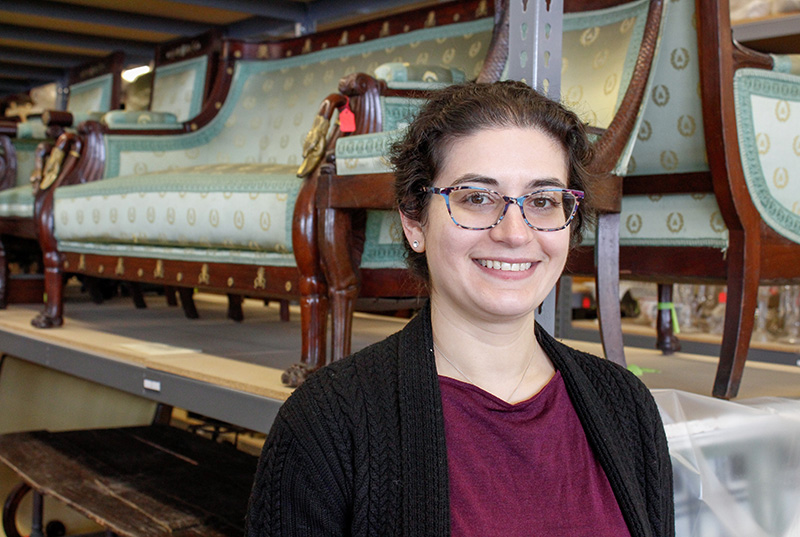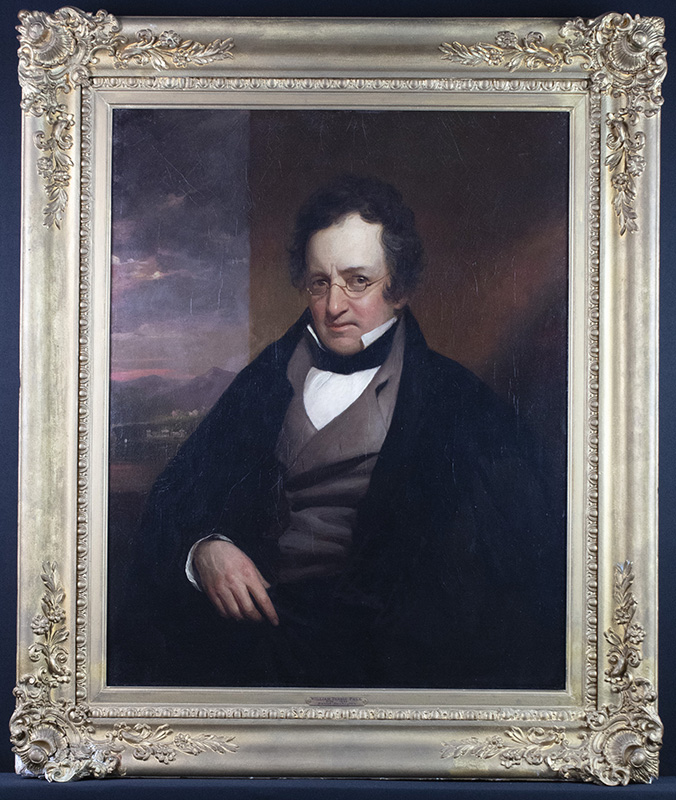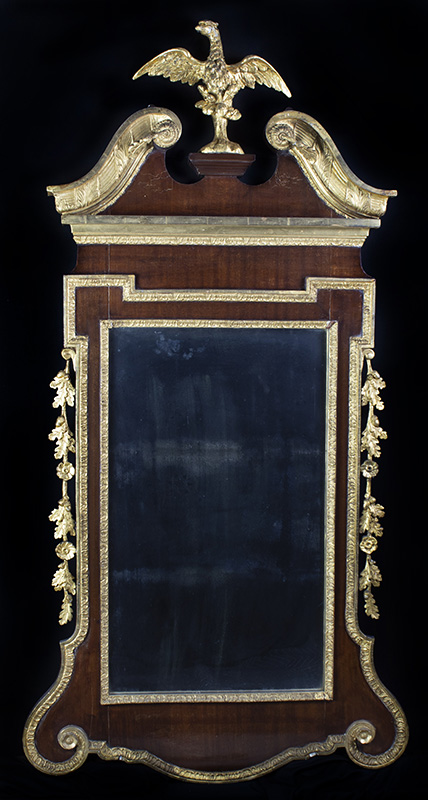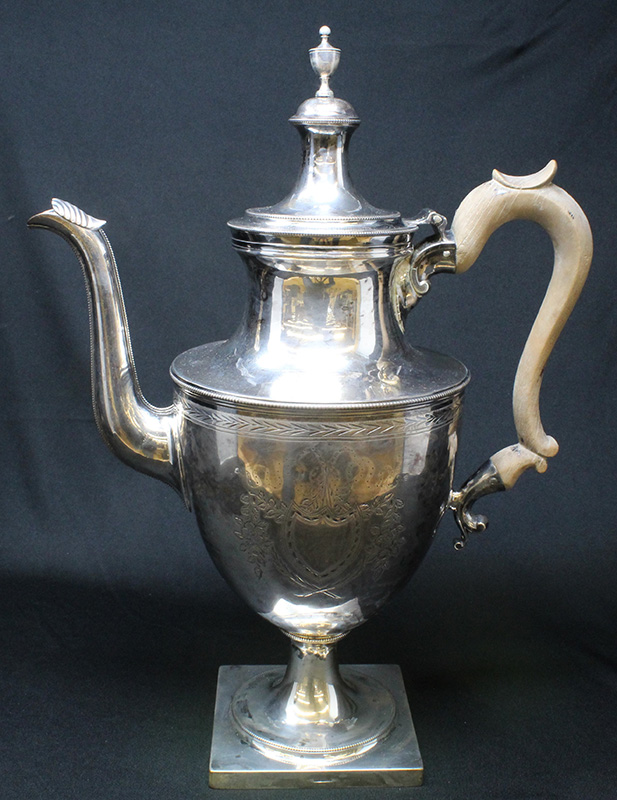Diving into the Pavilion Collection at Fort Ticonderoga
by Meredith Moore
As the Curatorial Assistant for the Pavilion Collection at Fort Ticonderoga (figure 1), a position funded in part by the Decorative Arts Trust, I am harnessing a background that corresponds to traditional curatorial positions. With an undergraduate degree in art conservation and a master’s degree in museum studies focusing on collections and exhibitions, I came to the position familiar with the decorative arts, particularly furniture.
The Pavilion (figure 2), a National Historic Landmark, was built as a private residence by William Ferris Pell (figure 3), who purchased Fort Ticonderoga in 1820, embarking on one of the first preservation efforts in American history. The Pavilion represents an early example of the American country house movement, far removed from the metropolitan centers on the Atlantic seaboard. Begun in 1826, the building grew over the ensuing decades, reaching its current form around 1837. The Pavilion served as a private residence, hotel, and tenant farmer’s home before being restored in the 1910s as a seasonal residence for Pell’s descendants. His great-grandson Stephen Hyatt Pell and wife, Sarah Gibbs Thompson Pell, began the restoration of Fort Ticonderoga and opened the site to the public for the first time in 1909.
Fort Ticonderoga and the Pavilion were shaped by a number of strong women. Sarah Gibbs Thompson Pell, a prominent suffragette, spearheaded restoration efforts in the early 20th century. The Pells commissioned renowned landscape architect Marion Cruger Coffin to design the iconic King’s Garden at Ticonderoga. Legendary interior decorator Dorothy May Kinnicutt Parish, better known as Sister Parish, redeveloped the Pavilion’s interiors shortly after she finished working at the Kennedy White House (figure 4).
A unique architectural structure in its own right, the Pavilion represents nearly two centuries of the Pell family’s legacy at Ticonderoga. Over the course of the 20th century, the Pell family amassed an eclectic collection of decorative arts. Furniture from Newport, New York, and France sat alongside family oil portraits going back to the 17th century and commissioned as recently as the 1960s. The building has sat vacant following the last resident family member’s death in 1987, but currently is undergoing a multi-million-dollar restoration and adaptive reuse that will significantly expand the Fort Ticonderoga experience.
I began my project by cross-referencing 16 inventories made over the course of a century, including the catalog records corresponding to the formal accession of certain objects in the Pavilion in the 1970s. Three insurance appraisals of the Pells’ home in New York City helped determine which objects were inherited from the Gibbs, Channing, and Pell families, and which were purchased from antique dealers in the early 20th century. The latter illustrate a focus on the coveted makers of that era, such as Duncan Phyfe, John Goddard, and William Savery. Pencil notes in the margins “at Ti” indicate how the Pells transported heirlooms that formed the core of their collection from Manhattan to the Pavilion.
Some of the most striking pieces descending through the Gibbs family are a suite of French Empire furniture (figures 1 and 4). Historic inventories state that these pieces were purchased by George Gibbs III, Sarah Pell’s great uncle, while he was in France serving Napoleon during the Cent Jours. These furnishings regularly made the trip between Manhattan and Ticonderoga, where they were showcased in the entrance hall of the Pavilion.
Another fixture from the entrance hall of the Pavilion is a Rococo mahogany mirror with a gilded eagle finial (figure 5), which was both inherited and purchased. The looking glass descended from Sarah Pell’s great grandparents through the Channing branch of the family, where it graced the study of Unitarian preacher William Ellery Channing. Sarah purchased the mirror from a distant cousin in the early 1930s in her effort to preserve family heirlooms and record their history.
The number of records for the Pavilion Collection in the database expanded dramatically following my first major cataloging effort with the silver. Described as “a large collection of silver stored in the Silver Room,” and accessioned under a single record, this project translated into more than 200 catalog entries representing over 900 objects, which are now numbered, described, photographed, and rehoused. The silver served as a test case for the ceramics and glass, many of which also fall under one record as “a large collection of porcelain, Venetian glass etc. in the Butler’s Pantry.”
A piece of silver that drew our attention during the intensive cataloging effort is a Neoclassical silver coffee pot (figure 6) by William Ball of Baltimore, MD, between 1800 and 1810. The size and decoration are striking: a tall urn-shaped body, attenuated lid mirroring its elegant foot, and an engraved band of laurel leaves above monogrammed cartouches. The monogram “S.G.” drew my attention. This coffee pot is one of the objects mentioned in the estate papers of Mary Channing Gibbs that was passed down through three generations of Sarahs until it became part of the Pavilion Collection.
Working with my supervisor, Curator Matthew Keagle, we are outlining the first exhibitions for the Pavilion once it reopens in 2021. Our focus is on three themes: Sarah Gibbs Thompson Pell’s role in the restoration of the Pavilion, King’s Garden, and Fort Ticonderoga; the historic preservation of the site by the Pell family; and decorative art highlights in the Pavilion Collection. Object lists for these installations are growing as the documentation for the collection continues to improve. We will include never-before exhibited furniture, ceramics, silver, and paintings.
Our selections include a tall case clock attributed to John Goddard, a center table and card table made by Duncan Phyfe, a French Empire chaise longue connected by family tradition to Napoleon, and portraits of William Ferris Pell (figure 3) and his wife, Mary Shipley, by Daniel Huntington and Thomas Sully. We will also incorporate a selection of the newly cataloged silver and soon-to-be-cataloged ceramics.
My experience at Ticonderoga has confirmed my desire to pursue a career in the museum field. I enjoy the opportunity to collaborate with colleagues throughout the institution, from collections management to development, and the freedom to take reasonable risks in a climate that encourages innovative approach to challenges. Most importantly, I have the opportunity to make a lasting contribution to the newly restored Pavilion at the prestigious Fort Ticonderoga. I am grateful to have an excellent foundation on which to build a successful career.
Meredith Moore is a Curatorial Assistant at Fort Ticonderoga in Ticonderoga, NY.
A print version of this article was published in The Magazine of the Decorative Arts Trust, one of our most popular member benefits. Join today!






